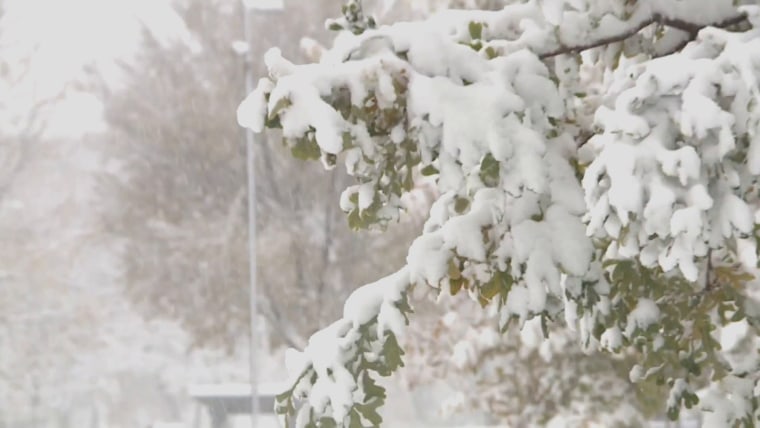An Arctic blast is expected to bring icy conditions to two-thirds of the nation from Monday and bring record cold to the South.
The cold air broke off from the polar vortex above Canada, sending the cold air south. New York Gov. Kathy Hochul urged people to use caution and prepare for the first winter storm of the 2025-26 season.
More than 84 million people are at risk and are under advisories, watches and warnings on freezing conditions, winter weather and snow in cities such as Dallas; Oklahoma City; Little Rock, Arkansas; New Orleans; Jacksonville, Florida; Atlanta; North Carolina cities Charlotte and Raleigh; and New York. Dozens of record lows could be set Tuesday.
Across the Great Lakes, the interior Northeast and the Appalachians, 28 million people are under winter weather alerts. The alerts include cities like Chicago; Milwaukee; Marquette, Michigan; Cleveland; Erie, Pennsylvania; and Charleston, West Virginia.
The blast is forecast to spread across the eastern two-thirds of the nation, and it could bring freezing temperatures to much of the South by Tuesday while setting low temperature records, the National Weather Service said in Sunday's national forecast discussion.
Parts of Florida are in for meteorological whiplash.
The temperature at Miami International Airport reached a hair under 85 degrees Fahrenheit Sunday afternoon, according to the weather service. A buoy on the Palm Beach County coastline measured an ocean temperature of 82 Sunday. By Tuesday, low air temperatures for parts of the Miami region were expected to dive into the 30s and 40s and feel even colder, federal forecasters said.
Record low temperatures could be seen Monday and Tuesday morning in Birmingham, Alabama; Tupelo, Mississippi; and in the Tennessee cities of Knoxville, Memphis and Nashville.
Afternoon highs in parts of the South were expected to be 10 to 25 degrees below normal. Heavy rain flooded roadways outside of Atlanta, stranding cars over the weekend, as freeze warnings were issued for Dallas and Austin.
Snow will fall from the Great Lakes to New England and northern New York state down to the mountains of eastern North Carolina by Monday and Tuesday. Storm totals of 12 to 18 inches are possible in parts of Indiana, Wisconsin, Michigan and West Virginia.
The frigid air mass was already bringing powder snow and lake-effect snow to parts of the Midwest on Sunday night. Parts of the Midwest saw storms including heavy snowfall and high winds, dangerous roads and bone-chilling temperatures overnight.
Intense lake-effect snow is likely through midday Monday, where snowfall rates of 3 inches per hour and wind gusts up to 30 to 35 mph will lead to life-threatening travel conditions.
Snow will taper off by Monday night for parts of Wisconsin, Illinois, Michigan and Indiana, but will continue into Tuesday for northeast Ohio, Pennsylvania and New York.
Video shared on social media showed heavy snow and low visibility in northern Wisconsin, lake-effect snow in northwest Indiana, and light snow falling in northern Illinois.
Michigan’s Upper Peninsula was blanketed by 11 inches of snow Sunday. And in Indiana, cars were sliding off of the road, causing traffic jams.
Lake-effect snow is produced when cold air moves over the relatively warm Great Lakes and picks up rising particles of water that rapidly form into snow bands.
Officials in the Chicago area's Cook County issued a "winter weather warning" for Sunday night through the end of Monday and advised motorists to stay off roads during lake-effect snowfall.
By early Monday, Chicago had already gotten nearly a foot of snow, but most of that snowfall is now finished. A number of schools in the city were closed Monday or were operating with a delayed opening or a switch to remote learning for the day because of the weather, according to NBC Chicago.
Hochul advised New York residents to expect 3 to 6 inches of snow in Chautauqua County and possibly 3 to 5 inches in Niagara and Orleans counties from late Sunday into Tuesday night. Some areas from Erie, Pennsylvania, and up the coast of western New York could see up to a foot of snow.
"Feels like" temperatures for parts of the state will dip into the mid-teens, her office said in a statement.
The lake-effect snow blanketed western New York by Monday morning, with the "feels like" temperature expected to drop as low as 10 degrees Monday.
The governor's office indicated the state shelter program known as "Code Blue" is likely to be activated, as it's triggered under state law when temperatures dip below 32. It mandates shelter, and longer shelter hours, for homeless people.
Hochul's office also said the state was prepared to respond to weather-related emergencies and has 1,571 large plow trucks, 148 medium-duty plows and 54 tow plows ready to be deployed to clear snow and disabled vehicles form roadways.
“State agencies are at the ready to assist New Yorkers and to ensure our communities remain safe during the first winter storm of the year,” Hochul said in the statement Sunday.
The Mississippi Emergency Management Agency urged people in the state to prepare for the coldest temperatures of the system Monday night into Tuesday by ensuring a sufficient supply of food, keeping dry firewood at the ready, and checking on elderly and disabled friends and neighbors.



